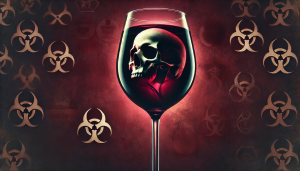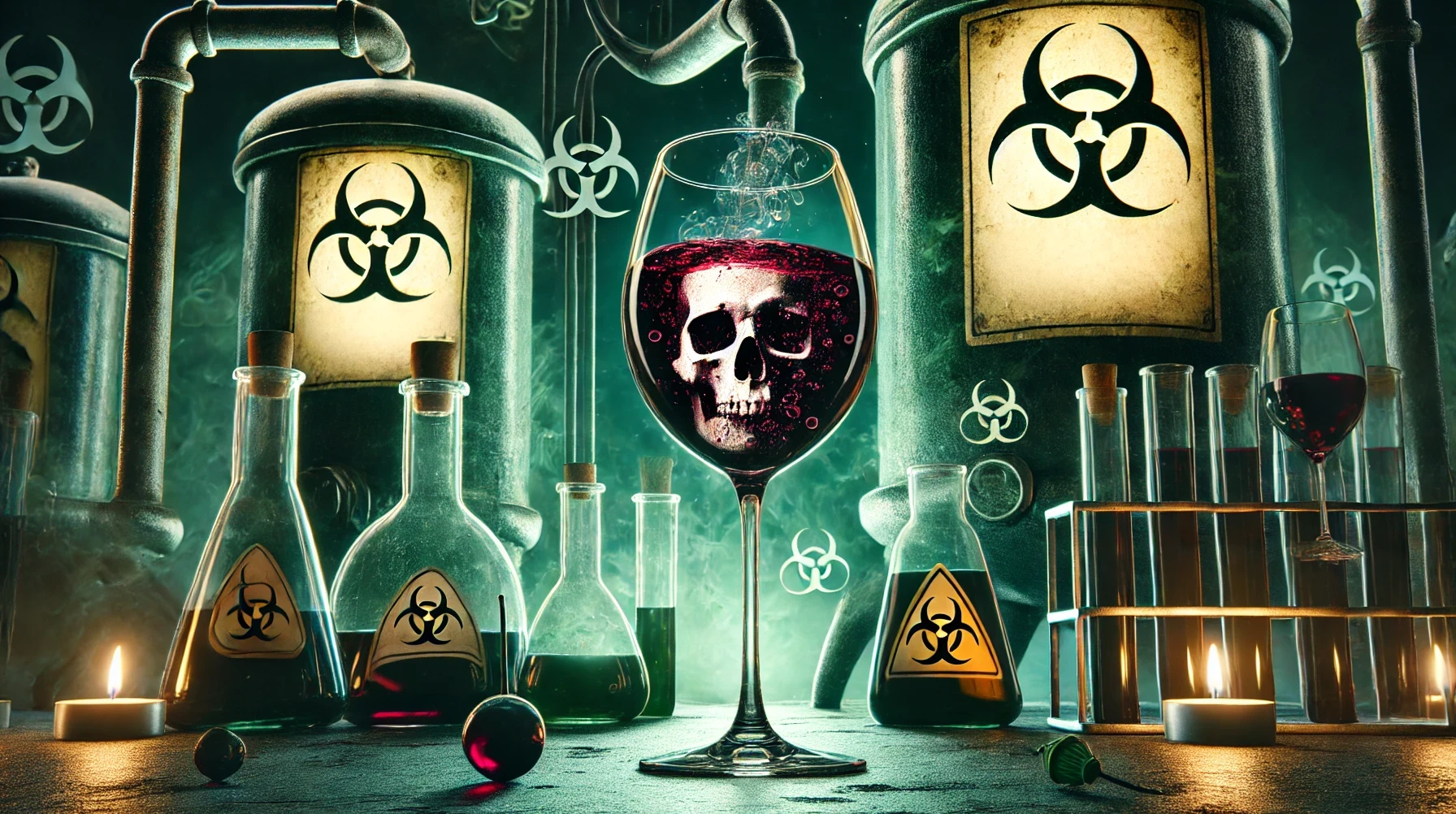What if the wine you’re sipping right now… isn’t just fermented grapes—but a chemical cocktail?
What if I told you… that your ‘healthy’ glass of wine… might contain fish bladders… industrial dye… and pesticide residue?
Sounds more like a chemistry experiment than a drink, right?
Well, stick around… because today we’re diving into the hidden additives… that could be making you sick.
And more importantly… how to avoid them.
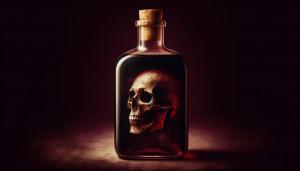
Welcome to The Wines Podcast
Hey there, wine lovers! I’m Veeno Bonovinotte… your go-to guide for making wine fun, informative… and most importantly… safe.
Now… I know what you’re thinking.
Wine is made from grapes. It’s natural… right?
If only that were true.
The reality? That innocent-looking bottle… might contain a laundry list of chemical additives… artificial sweeteners… heavy metals… and even animal byproducts.
And the worst part?
Wine bottles aren’t required to list ingredients.
Which means… you could be drinking things like…
🚨 Artificial colors… that make cheap wine look expensive.
🚨 Chemical preservatives… that extend shelf life… but wreck your gut.
🚨 Industrial sweeteners… that spike your blood sugar… and mess with your metabolism.
🚨 Animal byproducts… that, well… let’s just say aren’t exactly “vegan-friendly.”
And these aren’t here to improve quality.
They’re used to cover up flaws… in bad wine.
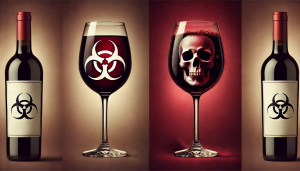
The Shady Wine Additives You Should Worry About—And How to Spot Them on the Label
Wine labels won’t give you the full story… but if you know what to look for, you can spot the red flags. Some wineries are more transparent than others, and while they’re not required to list every ingredient, the clues are there if you pay attention.
Here’s what to look for (and avoid) on the bottle:
💀 Mega Purple & Artificial Colors
What to look for: You won’t see ‘Mega Purple’ listed outright, but wines labeled as ‘enhanced color’ or ‘rich hue’ often contain synthetic dyes. Avoid wines that seem unnaturally dark or stain your glass.
💀 High-Fructose Corn Syrup (HFCS) & Excess Sugar
What to look for: Wines labeled as ‘sweet red blend,’ ‘smooth taste,’ or ‘enhanced mouthfeel’ often contain added sugars or HFCS. Some may even say ‘contains residual sugar (RS)’—higher RS means more added sweetness.
💀 Artificial Flavorings & “Oak Essence”
What to look for: If a wine says ‘oak-aged flavor,’ ‘oak extract,’ or ‘oak chips’ instead of ‘aged in oak barrels,’ it’s a shortcut using synthetic flavors.
💀 Gelatin, Isinglass, and Egg Whites (Animal-Based Fining Agents)
What to look for: If you’re vegan or allergic to eggs or fish, check for phrases like ‘traditional fining methods,’ ‘clarified with natural proteins,’ or ‘not suitable for vegans.’ Some bottles proudly state ‘vegan-friendly’—stick with those!
💀 Sulfites (a.k.a. ‘The Headache Chemical’)
What to look for: ‘Contains Sulfites’ is required by law in the U.S. and EU, but the amount isn’t listed. If sulfites give you headaches, look for wines labeled ‘low-sulfite,’ ‘no added sulfites,’ or ‘natural wine.’
💀 Pesticides & Herbicide Residues
What to look for: Conventional wines often contain traces of glyphosate (a weed killer) and other pesticides. To avoid them, choose wines labeled ‘organic,’ ‘biodynamic,’ or ‘made with organically grown grapes.’
💀 Copper Sulfate & Heavy Metals
What to look for: If a wine label mentions ‘corrective agents,’ ‘stabilizers,’ or ‘quality enhancers,’ that’s a red flag. Stick to producers who use minimal intervention winemaking.
The Solution: How to Drink Smarter & Avoid These Toxins
Okay… so now that we’ve completely ruined your favorite grocery store wine… let’s talk about what you can do… to drink smarter, healthier… and without all the garbage.
✅ Look for Organic, Biodynamic, or Natural Wines
These wines have minimal intervention… meaning no synthetic pesticides… no artificial flavorings… and little to no sulfites.
Some great producers?
🍷 Radikon (Italy)
🍷 Donkey & Goat (California, USA)
🍷 Frank Cornelissen (Sicily, Italy)
✅ Avoid Mass-Produced “Factory Wines”
If a wine is ultra-cheap… tastes unnaturally smooth… or is mass-marketed… it probably contains sweeteners, chemicals, and artificial flavorings.
✅ Choose “Low-Sulfite” or “No Added Sulfites” Wines
If sulfites give you headaches, look for brands like Cédric Bouchard (France) or Sainte-Marie des Crozes (Roussillon, France)—both use minimal sulfites.
✅ Use a Wine Purifier
If you can’t always get clean wine… use a purifier like Ullo or PureWine Wand… to remove sulfites, sediment, and impurities while keeping the flavor intact.
✅ Follow the “Transparency Rule”
If a winery doesn’t tell you what’s in their wine?
Assume the worst.
Support brands that proudly list ingredients and farming methods.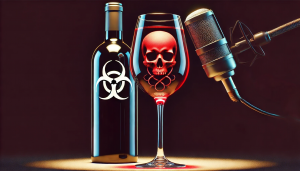
Recommended Product: The Ullo Wine Purifier
If you’re serious about drinking cleaner wine… I highly recommend the Ullo Wine Purifier.
It’s one of the best on the market for removing sulfites, pesticides, and chemical residues… while still preserving the full taste of your wine.
And I can tell you from experience… after using it, you can taste the difference.
No more headaches… no more mystery additives… just clean, pure wine… the way it was meant to be enjoyed.
Final Takeaway: Wine Should Be Pleasure, Not Poison
Look… I’m not here to tell you to stop drinking wine.
I’m here to help you drink the right kind of wine.
Your body deserves better than hidden chemicals, artificial dyes, and industrial sweeteners.
So here’s my challenge to you:
Next time you’re shopping for wine… flip the bottle over. Look for organic, biodynamic, or low-intervention wines.
And if you can’t find any? Ask the store manager why.
Because the more we demand better wine… the more the industry has to listen.
And if you care about what you drink as much as I do… tag a friend who needs to know what’s REALLY in their wine.
For my personal list of clean, high-quality wines… visit Bonovinotte.com.
Until next time… this is Veeno Bonovinotte reminding you…
Drink smart… stay healthy… and never settle for wine that doesn’t deserve you.
Cheers!
